International Carbohydrate Symposium
-
Al D. French
The 28th International Carbohydrate Symposium (ICS, www.ics-2016.org) was held in New Orleans, Louisiana, USA, 17-21 July 2016. The meeting followed a traditional format, starting on Sunday afternoon with the technical program closing on Thursday evening. The technical program was followed by a banquet at Mardi Gras World, a business that creates the floats used in Mardi Gras parades, that educates about this major event in New Orleans, and that provides a venue for receptions and banquets. With the exception of the banquet, a Tuesday evening Cultural Night held in the nearby St. Louis Cathedral, and a dinner for the country representatives to the International Carbohydrate Organization at a nearby restaurant, all of the meeting was held in the Marriott Hotel. As usual, Wednesday afternoon was free from technical programming, giving the participants time for tours of various destinations in and around New Orleans. The social program included a Sunday evening reception, while the Cultural Night included a jazz quartet and gospel choir. The banquet also included a jazz trio.
The meeting had the endorsement of IUPAC and the sponsorship of the American Chemical Society’s Division of Carbohydrate Chemistry and its Division of Cellulose and Renewable Materials, as well as its Louisiana Section. Sponsorship was also received from a number of commercial and university interests.
The meeting was organized under the auspices of the U.S. Advisory Committee for International Carbohydrate Symposia, with membership from the above two ACS Divisions. This committee is the designated organization in the USA to determine the location of ICS. Although the ICS Scientific Committee was otherwise dominated by members from the Carbohydrate Division, the Program Chair, Dr. Sheila Murphy, was the then-current chair of the Cellulose Division, while the Meeting Chair, Dr. Alfred French, has served as Chair of both Divisions at different times. The Scientific Committee was very involved in the selection of Plenary, Keynote, and Contributed Oral Lectures. The functions of registration, receiving abstracts, contract negotiation, etc. were provided by the American Chemical Society’s Conference Management Services.
The conference’s 505 attendees came from 39 different countries, with the largest contingent from the USA and the second largest from Japan. Visa problems were few in number and caused by very late application.
The program included three award addresses with presentations and a surprise award. The International Carbohydrate Organization’s $25,000 R. L. Whistler Award was presented to Benjamin Davis of Oxford University and its Young Researcher Award was presented to Benjamin Swarts of Central Michigan University.
Ben Davis spoke on “Sugars and Proteins”, delineating mechanisms of carbohydrate processing systems and their ligands to provide an understanding of their fundamental role in Biology and Immunology, as well as the use of molecules to modulate and manipulate such processes, with a strong associated potential for diagnosis, therapy, and application and intervention in medicine and other biotechnologies. In the final minutes, he described the possibility that the application of trehalose could help to substantially increase agricultural production.
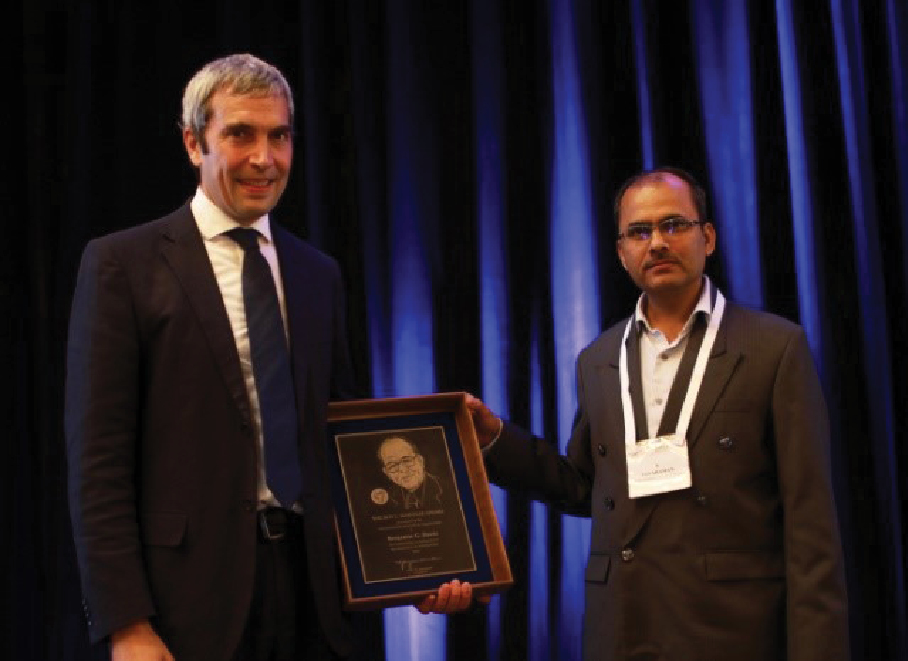
Benjamin G. Davis (left), Oxford University, is presented with the R.L. Whistler Award in Carbohydrate Chemistry by N. Jayaraman, President of the International Carbohydrate Organization. All photos in this report by Michael Santiago Cintrón
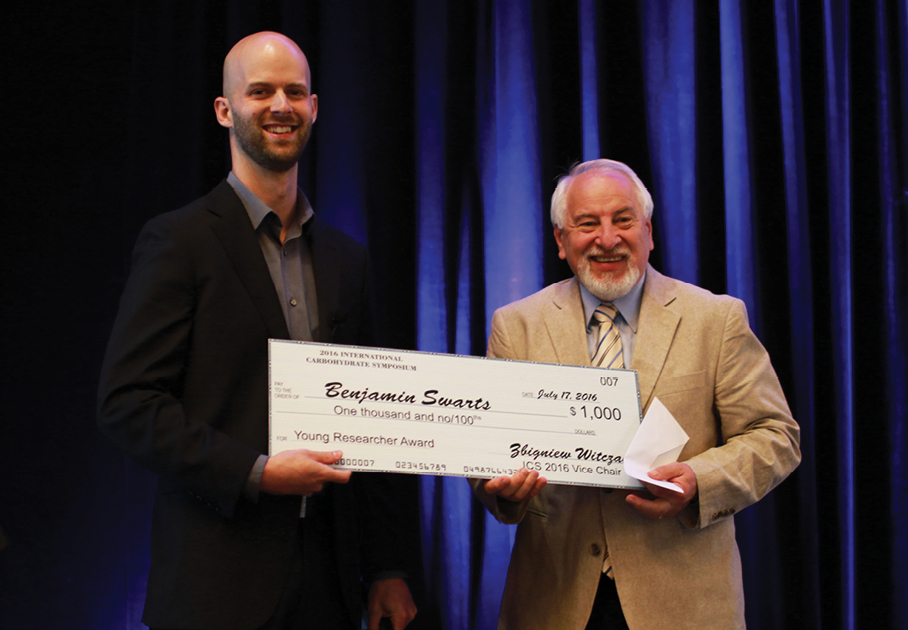
Benjamin Swarts (left), Central Michigan University, winner of the ICO Young Researcher Award, with Zbigniew Witczak, incoming President, International Carbohydrate Organization
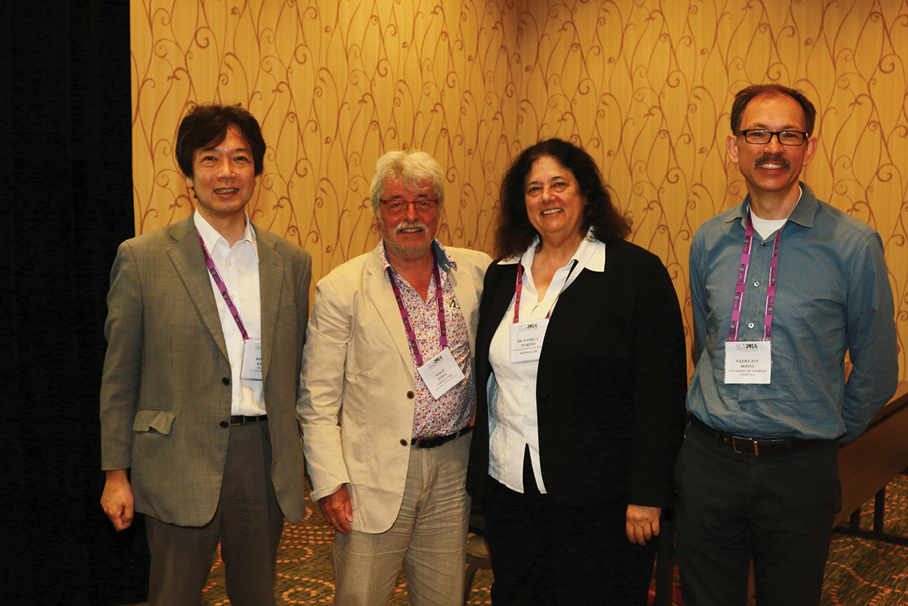
Left to Right: Dr. Koichi Kato, National Institutes of Natural Sciences, Japan; Serge Perez, former Scientific Director of the European Synchrotron Radiation Facility; Pamela Marino, National Institutes of Health, and Geert-Jan Boons, winner of the Claude S. Hudson Award
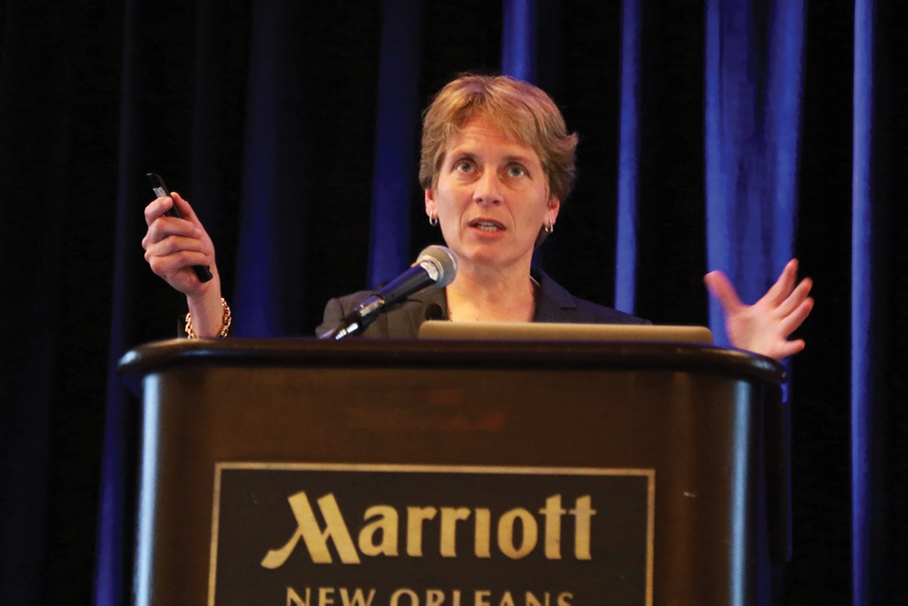
Carolyn Bertozzi, Stanford University, giving the Opening Plenary Lecture of the Symposium
Ben Swarts’ title was “Marking the mycomembrane: Chemical tools for studying and targeting glycolipids of the mycobacterial outer membrane.” The lecture focused on the development and applications of probes based on trehalose, a disaccharide that is central to mycomembrane biosynthesis but absent from humans. Mycomembranes are composed of arrays of distinctive glycolipids, including the trehalose- and arabinogalactan-linked mycolates that are important to mycobacterial physiology and pathogenesis. The award was sponsored by TCI America.
The Carbohydrate Division presented its Claude S. Hudson Award to Geert-Jan Boons, who described “An integrated approach to uncover ligands for heparan sulfate binding proteins”. The methodology has been employed to identify ligands for the ROBO-1, a protein involved in cell signaling and development. Furthermore, the synthetic HSoligosaccharides have been used for the development of a microarray and screening efforts have uncovered novel aspect of heparin sulfate-protein binding.
Megazyme’s Bruce Stone Award for Excellence in Plant Polysaccharide Biochemistry went to Harry Brumer, University of British Columbia. The Bruce Stone Award is presented as a surprise at appropriate international scientific conferences, in this case right after the contributed lecture “The evolution of carbohydrate-active enzyme specificity in genomes.” Brumer covered Glycoside Hydrolase family 16 (GH16) which comprises a large diverse group of enzyme specificities encoded by microbial and plant genomes. The specific biological role(s) of GH16 members remains enigmatic, but the present biochemical and structural characterization provides new insight into plant cell wall enzyme evolution, which will continue to inform genomic analyses and functional studies across species.
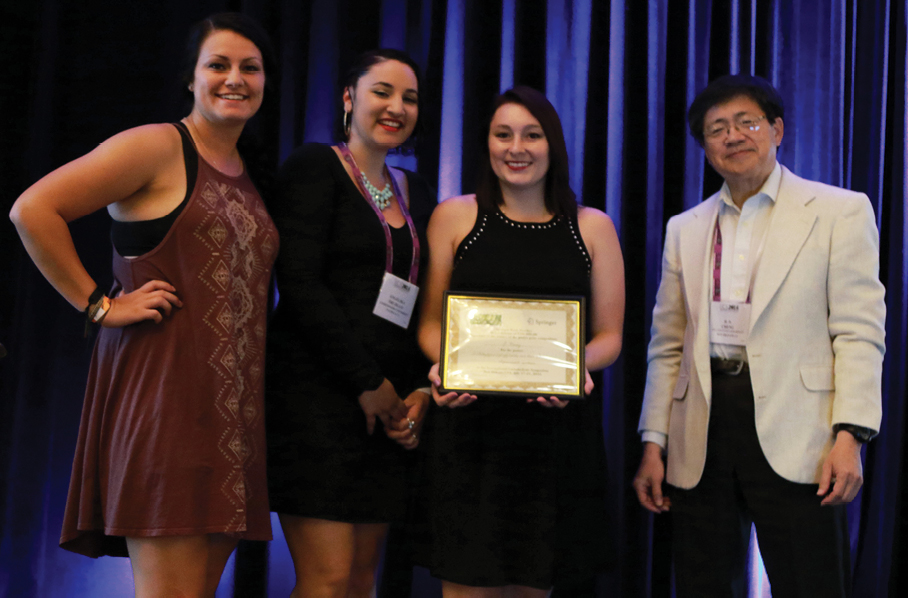
From left: Victoria Smith, Angelika Trujillo, and Jessica Causey, Lindenwood University, with H.N. Cheng, USDA, presenting a Poster Award
The eight plenary lectures and their titles were:
Carolyn R. Bertozzi, “Glycocalyx engineering toward probing cancer glycome evolution”
James C. Paulson, “Sialic acids as determinants of self”
Muthiah Manoharan, “GalNAc-conjugated oligonucleotides as a new paradigm in RNAi therapeutics for human diseases”
Soledad Penadés, “Glycans and glyconanotechnology”
Koichi Kato, “Structural views of glycan-dependent determination of glycoprotein fates in cells”
Stephen Withers, “Accessing new and improved CAZymes through metagenomics, synthesis and directed evolution”
Vincent Bulone, “A journey into the world of Eukaryotic cell walls: structure and biosynthesis of essential polysaccharides”
Bruce Hamaker, “Carbohydrate quality and how the concept may relate to healthier foods.”
The 32 invited keynote lectures headlined most of the five parallel sessions, which were completed by 203 contributed oral papers. A wide range of topics were covered in both the plenary lectures and oral papers. There were 200 posters on display throughout the meeting in the same area as the exhibits and coffee breaks. Poster prizes were awarded based on voting by meeting participants. Interest in the sessions was high, despite the location of the meeting at the edge of the French Quarter, a famous entertainment district.
There were several innovations at this meeting, with excellent participation. A special Sunday morning panel discussion on Directions in Glycoscience was presented. It was chaired by Geert-Jan Boons (University of Georgia), with panelists Pamela Marino, NIH (USA); Serge Perez, European Union ; and Koichi Kato, National Institutes of Natural Sciences (Japan). A session on new technology for characterization of carbohydrates was presented by representatives of instrument manufacturers. The sustainability of processes and products at DuPont were described in another organized session. Both of those sessions were keynoted by university faculty members, however. The program was available in printed form, except for the abstracts of the contributed papers, which were available in the full program presented in various electronic formats, including a smart device app.
Nikolay Nifantiev and Amelia Rauter have volunteered to shepherd the various lectures to publication in Pure and Applied Chemistry. Peer review is currently underway. The next International Carbohydrate Symposium XXIX ICS (2018) will be held in Lisbon, Portugal, 15-19 July 2018, organized by Professor A. Rauter.
©2017 by Walter de Gruyter Berlin/Boston
Articles in the same Issue
- Masthead - Full issue pdf
- From the Editorial Board
- Contents
- The First IUPAC World Chemistry Congress with a Latin Flavor
- Features
- IYCN: A Journey That Has Just Begun
- IUPAC Facilitating Chemistry Data Exchange in the Digital Era
- Nanomaterials—On the Brink of Revolution? Or the Endless Pursuit of Something Unattainable?
- Hero Worship in Words: Imitating the Grand Style of R. B. Woodward
- IUPAC Wire
- Awardees of the IUPAC 2017 Distinguished Women in Chemistry or Chemical Engineering
- Neil Garg is the Recipient of the 2016 Thieme–IUPAC Prize
- The Franzosini Award of 2016
- A Global Approach to the Gender Gap in Mathematical and Natural Sciences: How to Measure It, How to Reduce It?
- New InChI Software Release
- Project Place
- Database on Molecular Compositions of Natural Organic Matter and Humic Substances as Measured by High Resolution Mass Spectrometry
- Integrating Green Chemistry and Socio-Sustainability in Higher Education: Successful Experiences Contributing to Transform Our World
- NUTRIAGEING: Combining Chemistry, Cooking, and Agriculture
- Safety Training Program
- The Silver Book and the NPU Format for Clinical Laboratory Science Reports Regarding Properties, Units, and Symbols
- Bookworm
- Engineered Nanoparticles and the Environment: Biophysicochemical Processes and Toxicity
- Compendium of Terminology and Nomenclature of Properties in Clinical Laboratory Sciences
- Making an ImPACt
- Isotope-Abundance Variations and Atomic Weights of Selected Elements: 2016 (IUPAC Technical Report)
- Names and Symbols of the Elements with Atomic Numbers 113, 115, 117 and 118 (IUPAC Recommendations 2016)
- On the Naming of Recently Discovered Chemical Elements—the 2016 Experience
- IUPAC Provisional Recommendations
- Terminology of Bioanalytical Methods
- Nomenclature and Terminology for Dendrimers with Regular Dendrons and for Hyperbranched Polymers
- Definition of the Mole
- Terminology of Separation Methods
- NOTeS
- IUPAC Standards and Recommendations
- Conference Call
- Chemical Industry of Sustainable Development
- Bioinspired and Biobased Chemistry & Materials
- International Carbohydrate Symposium
- Validation of Test Methods, Human Errors and Measurement Uncertainty of Results
- Where 2B & Y
- Chemistry in a Multidisciplinary, Interdisciplinary World
- Trace Elements Analysis of Environmental Samples with X-rays
- Ionic Polymerization
- Global Challenges and Data-Driven Science
- Mark Your Calendar
Articles in the same Issue
- Masthead - Full issue pdf
- From the Editorial Board
- Contents
- The First IUPAC World Chemistry Congress with a Latin Flavor
- Features
- IYCN: A Journey That Has Just Begun
- IUPAC Facilitating Chemistry Data Exchange in the Digital Era
- Nanomaterials—On the Brink of Revolution? Or the Endless Pursuit of Something Unattainable?
- Hero Worship in Words: Imitating the Grand Style of R. B. Woodward
- IUPAC Wire
- Awardees of the IUPAC 2017 Distinguished Women in Chemistry or Chemical Engineering
- Neil Garg is the Recipient of the 2016 Thieme–IUPAC Prize
- The Franzosini Award of 2016
- A Global Approach to the Gender Gap in Mathematical and Natural Sciences: How to Measure It, How to Reduce It?
- New InChI Software Release
- Project Place
- Database on Molecular Compositions of Natural Organic Matter and Humic Substances as Measured by High Resolution Mass Spectrometry
- Integrating Green Chemistry and Socio-Sustainability in Higher Education: Successful Experiences Contributing to Transform Our World
- NUTRIAGEING: Combining Chemistry, Cooking, and Agriculture
- Safety Training Program
- The Silver Book and the NPU Format for Clinical Laboratory Science Reports Regarding Properties, Units, and Symbols
- Bookworm
- Engineered Nanoparticles and the Environment: Biophysicochemical Processes and Toxicity
- Compendium of Terminology and Nomenclature of Properties in Clinical Laboratory Sciences
- Making an ImPACt
- Isotope-Abundance Variations and Atomic Weights of Selected Elements: 2016 (IUPAC Technical Report)
- Names and Symbols of the Elements with Atomic Numbers 113, 115, 117 and 118 (IUPAC Recommendations 2016)
- On the Naming of Recently Discovered Chemical Elements—the 2016 Experience
- IUPAC Provisional Recommendations
- Terminology of Bioanalytical Methods
- Nomenclature and Terminology for Dendrimers with Regular Dendrons and for Hyperbranched Polymers
- Definition of the Mole
- Terminology of Separation Methods
- NOTeS
- IUPAC Standards and Recommendations
- Conference Call
- Chemical Industry of Sustainable Development
- Bioinspired and Biobased Chemistry & Materials
- International Carbohydrate Symposium
- Validation of Test Methods, Human Errors and Measurement Uncertainty of Results
- Where 2B & Y
- Chemistry in a Multidisciplinary, Interdisciplinary World
- Trace Elements Analysis of Environmental Samples with X-rays
- Ionic Polymerization
- Global Challenges and Data-Driven Science
- Mark Your Calendar


